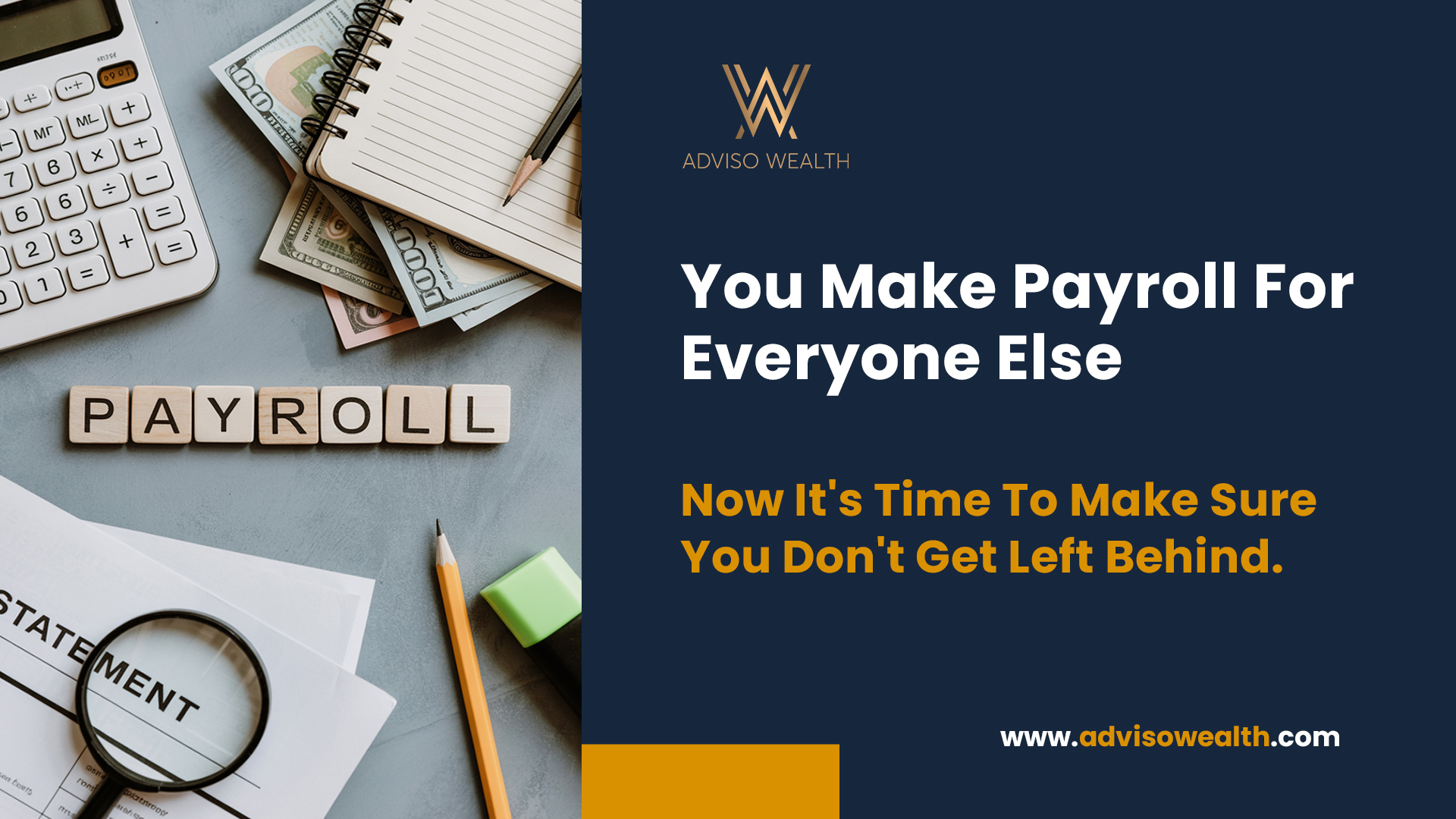You Make Payroll for Everyone Else

Now it’s time to make sure you don’t get left behind.
You Pay Everyone—But Who Pays You?
Every two weeks, the same story plays out.
You’re making sure your employees get paid.
Vendors get paid.
Taxes get paid.
Health insurance premiums get paid.
Retirement plan contributions get deposited.
You do all of this—on time. Without complaint. Without anyone needing to remind you.
You’re the reason a dozen families sleep better at night.
But here’s the hard question:
Are you building the same financial security for yourself that you’re building for everyone else?
Because what I see, again and again, is this:
The business owner who funds everyone’s lives… forgets to fund their own.
The Silent Cost of Being the Responsible One
You built your business with grit. You’re not afraid of hard work. You take pride in making sure people are taken care of.
And when you’re wired that way—responsible, loyal, generous—it’s easy to put yourself last.
You say things like:
“I’ll take a bigger draw next year.”
“I just want to make sure we hit our revenue targets first.”
“We’re hiring right now, so I need to be conservative.”
“We need new equipment.”
“I don’t want to seem greedy.”
Here’s the problem:
There’s no line item for you.
And because you’re the only one responsible for making it all work, no one’s going to create one for you.
The Financial Planning Gap for Business Owners
You know this intellectually, but you may not have made it a priority:
Your business is not your retirement plan.
Yes, it’s an asset. But it’s also a risky one.
You wouldn’t advise your best friend to put 90% of their net worth into a single private company with no exit plan, no dividend strategy, no buy-sell agreement, and no idea what it’s worth.
But that’s exactly what many business owners do—with their own business.
You don’t just have a tax problem. You have a planning problem.
Let’s break it down.
The Five Silent Drains on Your Personal Wealth
Most of the business owners I work with aren’t making “big mistakes.”
They’re making small omissions that compound quietly over time:
1. Your salary isn’t optimized for wealth building.
You may take too little in W-2 income (hurting your retirement plan contributions), or too much (triggering unnecessary payroll taxes). There’s no strategy behind the numbers—it’s whatever your bookkeeper says you can afford.
2. Your retirement plan is underutilized.
You set up a SEP or SIMPLE years ago. It worked… then. But now you’re earning multiple six figures, and you could be using a Cash Balance Plan, a defined benefit plan, or a 401(k) with a mega backdoor Roth option—saving $100K+ in taxes annually. You’re not.
3. You don't know what your business is worth.
How can you plan for the future if you don’t know your net worth? Without a clear valuation—or at least a reasonable range—you’re operating blind. You’re hoping it’s worth $5M when maybe it’s only worth $2M. Or vice versa.
4. Your wealth is tied up in an illiquid asset.
Your business might generate $1M+ a year in revenue—but what do you actually own outside the business? Most owners I meet don’t even have a personal investment account. If the business stalls, everything stalls.
5. You have no exit timeline.
You say things like, “I’ll work until I don’t want to anymore,” or “My kids might take over,” or “I’ll sell it eventually.”
But an undefined exit is a dangerous default. You need a clear runway—a 5-year plan that aligns your business trajectory with your personal goals.
A Personal Story: The $1.2M Earned, $200K Saved Paradox
One of my clients, a brilliant service-based business owner, made $1.2 million in income last year. That’s after payroll, taxes, overhead.
When we looked at his personal balance sheet, he had:
- $200K in his SEP IRA
- $75K in his brokerage account
- A $1.3M home, mortgaged
- And a business he hoped would sell for “a few million someday”
That’s it.
No exit plan. No succession strategy. No disability insurance. No backup if he burned out or got sick.
He had been making payroll for everyone else… but not himself.
Now, we’re working together to change that.
We’ve set a target valuation, started building personal liquidity, maxed out his tax-advantaged contributions, and put a 5-year sale plan in place.
He sleeps better.
His spouse feels safer.
And for the first time in a decade, he’s not running on fumes.
Your Business Is a Vehicle—Not a Life Sentence
You started this business for freedom.
Freedom of time.
Freedom of income.
Freedom to call the shots.
But over time, that freedom can erode. You find yourself in a strange prison—one you built yourself.
Where you have to keep going, because there’s no alternative.
That’s what happens when you don’t build personal wealth alongside business wealth.
You become indispensable to your company—when your goal was to become optional.
So here’s what we do instead.
The Wealth-Building Playbook for Business Owners
1. Pay yourself first—with strategy.
We align your salary, distributions, and entity type to maximize tax efficiency and personal wealth accumulation. If you’re not taking home six figures in investable cash, you’re falling behind.
2. Upgrade your retirement plan.
It’s not just about having a plan—it’s about having the right plan. That could mean layering a 401(k), profit-sharing, and cash balance plan to supercharge your savings and reduce your tax burden.
3. Get a valuation—or a valuation proxy.
We help you get an independent perspective or a qualified estimate of your business value. Then we update it annually, just like any other portfolio asset.
4. Start the exit runway early.
Even if you’re not planning to sell for five or ten years, start planning now. You wouldn’t run a marathon without training. Why would you try to exit your business without a roadmap?
5. Build liquid, personal wealth.
You should be investing outside the business every single year. Think of it as your “Option Fund”—the money that gives you freedom to walk away, reinvest, or take a sabbatical.
Why This Matters So Much
Because you matter.
You’re not just the engine behind your company—you’re a human being with dreams, obligations, a family, and a future.
You didn’t sign up to be a martyr.
You didn’t build a business so you could have less freedom than your employees.
And yet that’s where too many business owners end up.
Working 60-hour weeks. Worrying about payroll. Holding their breath every tax season. Falling asleep at the wheel of their own financial life.
It doesn’t have to be that way.
Don’t Wait for Burnout or a Buyout
By the time most owners reach out to a financial planner, they’re already tired. Or in the middle of an unsolicited offer. Or facing a health scare. Or wondering why they feel behind when they’ve built so much.
But the best time to build your financial plan was when you started your business.
The second best time? Now.
And it starts with a single conversation.
Let’s Talk.
If this blog post hit home—if you’ve ever felt like you’re doing everything for everyone else—I want to invite you to do something for yourself.
Book a Clarity Session with me.
This isn’t a sales pitch. It’s a chance for us to sit down, look at your personal and business finances side-by-side, and start crafting a roadmap that serves you—not just your business.
You make payroll for everyone else.
Let’s make sure you’re paying yourself—with clarity, purpose, and peace of mind.
Disclaimer
All written content is for information purposes only. Opinions expressed herein are solely those of Adviso Wealth, unless otherwise specifically cited. Material presented is believed to be from reliable sources and no representations are made by our firm as to another parties’ informational accuracy or completeness. All information or ideas provided should be discussed in detail with an advisor, accountant or legal counsel prior to implementation.
